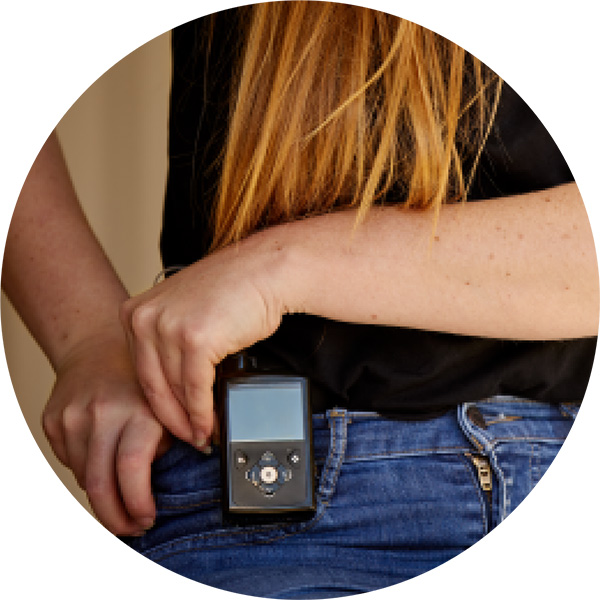
Insulin pump therapy
About insulin pump therapy
Insulin pump therapy, also called continuous subcutaneous insulin infusion (CSII) mimics the physiological function of a normal pancreas. Compared with MDI, it can provide:
- More flexibility1,2
- Less hypoglycaemia6
- Improve control – especially overnight4,5
- Fewer fluctuations in blood glucose levels7
Insulin pump therapy uses only rapid-acting insulin, which is absorbed more predictably and precisely than multiple daily injections. It provides more complete information, allowing people with T1D to make more confident decisions.
HbA1c

- A person’s HbA1c score is integral for diabetes control but is not the only indication of being healthy
- Wide fluctuations in blood glucose levels may show that the HbA1c goal is achieved because the average is good, but does not capture important variables, such as time spent high or low
- Time in range can provide additional insights beyond A1c, including visibility of high and low glucose levels throughout the day

Insulin pump therapy as a system
Insulin pump therapy, also called continuous subcutaneous insulin infusion (CSII) mimics the physiological function of a normal pancreas. Compared with MDI, it can provide:
An insulin pump is a durable electronic device that consists of:
- A compartment that holds a reservoir
- The reservoir (which is filled with insulin)
From the reservoir, insulin is infused into the patient’s body through an infusion set. The infusion set is inserted into the body and is infused through a tiny cannula that sits just underneath the skin.
Insulin pump therapy includes programmed insulin and ‘on-demand’ insulin.

Basal rate
- Programmed insulin rate made up of small amounts of insulin, delivered continuously
- Mimics the basal insulin produced by the pancreas
- Basal rate can be determined based on patient’s needs
- Basal rate can be customised according to specific daily needs and suspended or altered for a definite time frame (which is not possible with long-acting insulin injections)

Bolus rate
- The additional insulin that can be delivered ‘on-demand’ to match the meal plan or correct high blood glucose
- Insulin pumps have Bolus calculators that help patients calculate their Bolus amount, based on pre-determined settings

Hypoglycaemic
episodes
reduced up to
84%6
Benefits of insulin pump therapy
Glycaemic control
Compared with MDI, insulin pump therapy may provide greater glycaemic control4, 5. People are also 4 times more likely to achieve their HbA1c goals with insulin pump therapy vs MDI.4 Furthermore, insulin pump therapy provides greater stability of glucose levels.7
Precision
Rapid-acting insulin, used in insulin pumps, is absorbed more precisely and consistently than long-acting insulin used in MDI.7 Rapid-acting insulin is also less variable when administered via a pump, compare with a subcutaneous injection.3, 8
Long-term outcomes
There are many reasons why people with T1D choose insulin pump therapy. Aside from reducing hypoglycaemic episodes by up to 84% versus MDI6, insulin pump therapy can also help reduce the risk of long-term complications, such as cardiovascular, nerve, kidney and eye damage.11
An insulin pump can help your patients reduce the risk of long-term complications7, 9 like:

Fatal cardiovascular disease10
reduced up to
42%

Nerve damage (neuropathy)9
reduced up to
60%

Kidney damage reduced up to9
reduced up to
54%

Eye damage (retinopathy)9
reduced up to
63%
Convenience
People who have switched to an insulin pump describe a range of advantages over MDI, including convenience factors, such as:*1,2
- Fewer injections*
- More flexibility to choose what and when to eat2
- Easier with exercise1
- Easy to bolus in public1
- Ability to increase or decrease background insulin for last-minute changes1
Cost
For people eligible and registered with the National Diabetes Services Scheme (NDSS), monthly insulin pump consumables costs will be around AU$25-30.


Is pump therapy right for your patients?
Insulin pump therapy may be beneficial for use by children, adolescents and adults who:
- Have poorly controlled HbA1c
- Want to improve their HbA1c
- Want a more flexible therapy
- Have onset or concerns of long-term complications
- Experience dawn phenomenon
- Have needle phobia
- Have gastroparesis
- Have more than two severe hypoglycaemic events in the last 6 months
- Have hypoglycaemia unawareness
- Have an inconsistent schedule
- Are pregnant or planning to concieve
- Are not having their needs met by MDI
Learn more
References
* Based on four injections per day for 30 days and one infusion set change every 2–3 days.
1. Data on file. Data collected by an independent Diabetes Educator.
2. Grose DN et al. Practical Diabetes. 2018;35(5 September).
3. Pickup JC. N Engl J Med. 2012;366(17):1616–1624
4. Doyle EA et al. Diab Care. 2004;27(7):1554–1558
5. Karges B et al. JAMA 2017;318(14):1358–1366. 6. Bode BW et al. Diab Care. 1996;19:324-327.
7. Lauritzen T et al. Diabetologia. 1983;24(5):326–329.
8. Heinemann L et al. Diabetes Care. 1998;21(11):1910–1914.
9. The Diabetes Control and Complications Trial Research Group. N Engl J Med. 1993;329:977–986.
10. Steineck I et al. BMJ. 2015;350:h3234
11. US Enlite Clinical Study Customer Satisfaction Survey. Data on File. Medtronic MiniMed, Inc, Northridge CA.